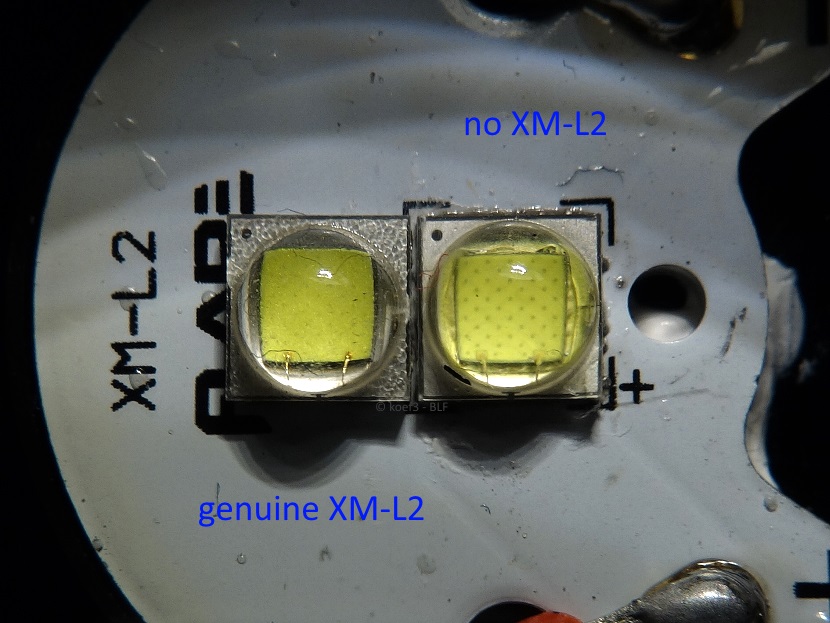LED test
Unknown 5050 SMD LED similar to Cree XM-L2
A few weeks ago I ordered a Revtronic F30B (formerly known as 'Nitefighter' F30B) flashlight. My intention was to use this light as host and remove the driver and LED.
As I would expect, there was not an original XM-L2 inside, but a 'counterfeit' model.
Because of this (also after long search manufacturer and part no. are unknown to me) there's no datasheet or other informations. It's also unknown to me where you can get this LED.


The LED chip was made in classic lateral design, the two bonding wires including the solder pads are visible. There is a similarity to the known Cree XM-L2, also the substrate color and the arrangement of dots on the yellow phosphor layer are almost the same. Because (not only) of this I think that the manufacturer used a Cree EZ1950-p LED chip (datasheet here, pdf) which can purchased from Cree directly.
Around the LED chip itself yellow stains are visible. Under the chip a sort of thermal- or solder paste was squeezed out in production process and is visible in top view. The outer size is 4.985 x 4.985 mm (0.196 x 0.196 in, known as '5050 size') and it fits on a XM board easily as well.

On the picture the left corner of the grey substrate is broken. I'm not sure that was caused by the production or the assembly process of the flashlight.
Here the comparison with a genuine Cree XM-L2 LED (left).



The light emitting surface (LES) of this emitter is only 7.75 mm² (0,0120 sq in) in size. This is also smaller than of the XP-L and XM-L2 (approx. 8.6 mm²). In the second picture of the die you can see that the highest luminance on the chip surface is reached near the bonding wires. In the next time I will standardize these pictures to get a real comparison option between different LEDs.
25 °C Tsp, unless noted otherwise.

Overcurrent:
- maximum current: 8,400 mA (2,289.3 lm @ 4.09 V) - at 8,500 mA death of LED
- power at maximum 34.4 W
- efficiency at maximum 66.5 lm/W
- sweet spot at 5,800 mA (1,917.4 lm @ 3.57 V)
- power at sweet spot 20.7 W
- efficiency at sweet spot 92.6 lm/W
I define the sweet spot as the position in the diagram which gives a good average between light flux, current and efficiency. In most cases it lays roughly 15 to 35 percent lower than maximum possible light flux.
This LED delivers an very surprising high amount of light flux! It is almost as good as the Cree XP-L in bin V5, and can handle much higher current than the (newer version) XM-L2 U2. Also the Vf is much lower than of the other LEDs! At 8,500 mA the bonding wires are blown, the same limiting factor known from XM-L2 and many other LEDs. I recommend a maximum current of 7,400 - 7,800 mA and not more than 3.8 - 3.9 V to stay on the safe side.
The performance behavior is almost the same as of the original XP-L V5 and XM-L2 T5/T6. This supports my guess that the unknown manufacturer uses an original Cree EZ1950-p chip to produce the light in the LED.
Because of the smaller LES the luminance at the same light flux will be higher as of the XM-L2! Especially in dedomed state this LED could break some luminance values known from XM-L2 and Luminus SST40-W. Unfortunately I cannot test this anymore because this LED was the only I had. Overall I am very interested to get the official manufacturer and supplier of this LED.
The tint was very nice. It was a clear white at approx 6000 K CCT, without any green or yellow color in it. But I had to say that this is valid only for my LED; in other cases the tint might be completely different. Maybe one of you know the true manufacturer/type of this LED or could name a supplier of it - it would be an interesting LED to build thrower with the XM footprint.
Thanks for reading!
Greetings, koef3
Mistakes and suggestions are best sent via pm.



